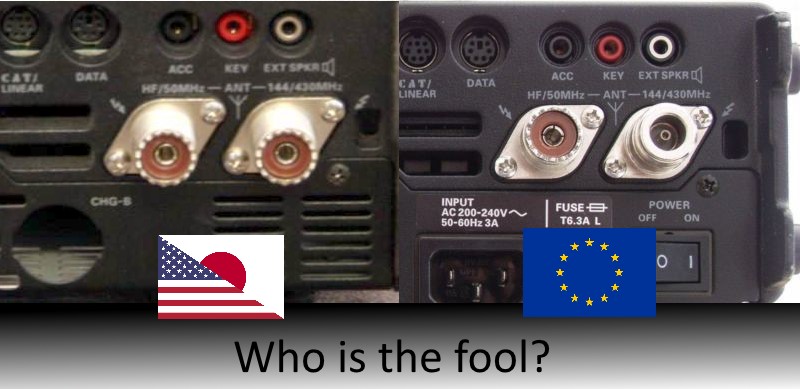
(Note: this article is available also in Russian, thanks to Oleg UA9UAX!)
[Read also the follow-up: PL-259 vs. N, round 2: hard testing]
Ham radio makers often offer two distinct connectors for the 2m/70cm port: N for the European market, SO-239 for USA/Japan and the rest of the markets.
This is taken from the Yaesu FT857 manual:

Here in Europe I often read on ham radio forums that type-N connectors are mandatory in 70cm operations due impedance mismatch caused by PL-259, that provokes a relevant attenuation in the lower UHF band. The difference is often described as “huge” and very important for the successful setup of a 70cm station.
However, unlike other gear like cables and so, that report attenuation per meter at a given frequency, I have never been able to see a figure that actually describes the amount of this “huge” loss. In other words, what are we Europeans really gaining with the more expensive and complex N connectors?
To answer myself this question, I make a TL (Transmission Loss) measurement on a cable with two N connectors and with a SO-239/PL-259 pair.
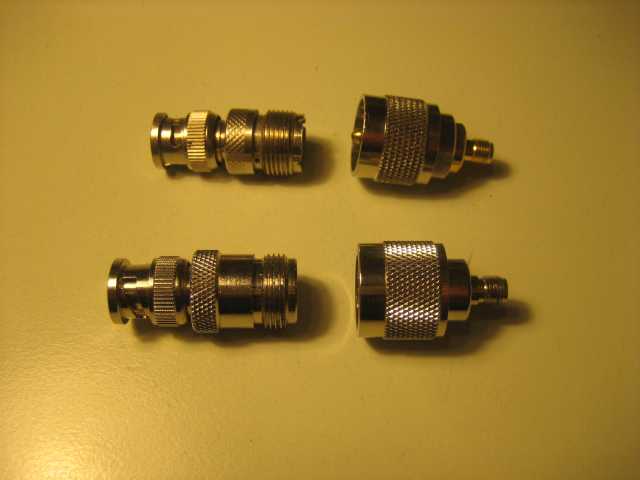
I set up a R&S signal generator for 0dBm @431.000 MHz:
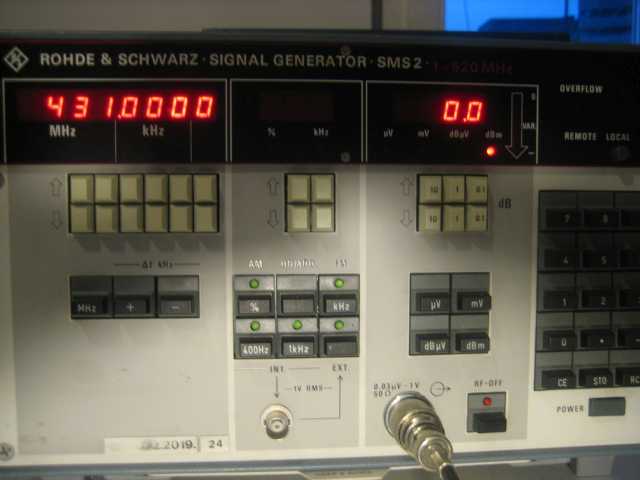
Then I fed the connection with the N-N pair to a spectrum analyzer:
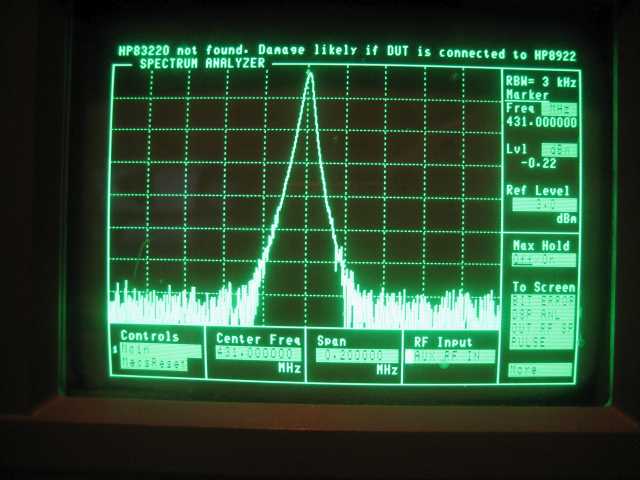
The readout is -0.22dBm, i.e. 0.22 dB lost in the RG-58 cable, connectors, etc.
Then I replaced the N-N pair with a PL-259/SO-239 pair and repeated the measurement:
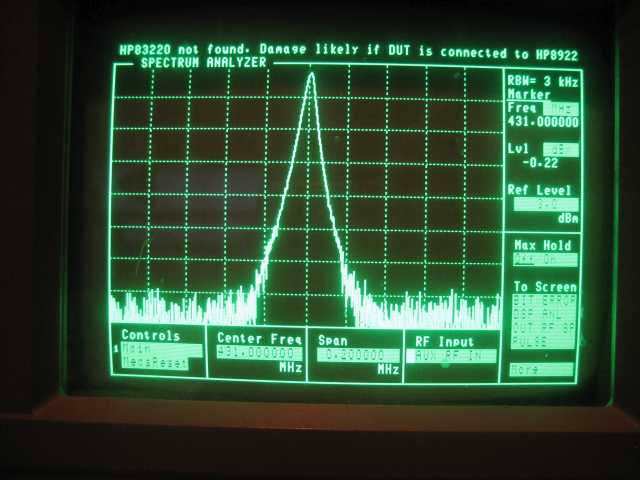
What? -0.22 again? Exactly the same amount as before. The HP spectrum analyzer didn’t notice the swap!
With this setup I can appreciate differences of 0.1dB among two signals. So I tried with a Vector Network Analyzer, that reports hundreds of dBs.
I calibrated the N pair as “0” then replaced it with the PL-259/SO-239 pair. This is the result:

The difference is 0.01dB (in favor of the PL-259/SO-239 pair), which is completely meaningless because is within the measurement noise.
In other words, neither the VNA has been able to tell the difference.
In summary, two different measurement methods have not been able to tell the difference among a N/N pair and a SO239/PL259 pair at 431 MHz: despite of the claims, I can hardly believe that any human operator would be able to do any better.
Read also the follow-up: PL-259 vs. N, round 2: hard testing


Well experimented. We need to continue such technical works to keep this unique hobby alive and interesting.
De
VU2DED
Great experiment & well explained. It would be great if you can do the same experiment with an adapter. I.E. pl259 to n-type. Thanks for sharing your experience.
And what about the variation due to manual assembly of the connector to the cable? When the measurement would be repeated with more samples of each type that are assembled manually, a lot more deviation between N and PL is expected.
I replaced almost all my PL-259/SO-239 by N-type, because of the MECHANICAL pro’s of N-type.
IMHO PL-259/SO-239 is nice enough for CB operations. Serious HAM’s prefer N-type for ALL frequencies!
There is a lot of (Chinese) crap on the market with PL-259/SO-239! Please be aware of this. Don’t use them with QRO (on HF too)!
For many years I use N-type (male and female) connectors from Rosenberger or Suhner. I pay about 2 Euro’s for them.
I would never take any risks using other type connectors than N, or other brands than the above mentioned.
Just my opinion…
Interesting; I have been using cheap Chinese PL259 and N type connectors for years (Direct From China), 25 cents per pair of N type connectors, and the VNA does not lie, no issues that would concern me!
. Ha! What a joke. Millions of “serious” hams have been using 259/239 for decades and this study debunks the supposedly advantage of the “N” connectors.
Thats great that you have an “Opinion” which works well for you, Hanns. What was dealt this article was measurable and observable science fact. Your “Opinion” that Hams that who do not agree with you are not “Serious” is laughable.
I’m glad your use of “N” Connectors makes you feel superior. Understand, that this too is just an opinion…an egotistical and false one.
Hi, a N-connector is at least water proof. 73 PA2DB
Very good remark Marcus!!
Just what you need when you go in the shower with the radio 😉
Some times I go in the shower with my antennas 🙂
Only when proper o-ring is supplied…
Thank you dear friends for your comments. However I would like to underline that this article is not about the general differences among the N and PL. Instead, it tries to put some figures on the performance price, real or perceived, that people owning UHF radio factory fit with a SO-239 pay versus the same model but with the N connector.
Let’s remind that the UHF radios factory fit with SO-239 are mainly FM vehicular (for example, my Icom IC-2725 has a SO-239); the only all-mode exception, as far as I know, is the 857/897 Yaesu series. So we are talking mostly about rag-chewing on the local repeater.
Personal tastes aside, how can we quantify the difference among the EU N-version and the USA/J PL one?
Issues like water proofing and power handling are very good points, but out of topic: these radio aren’t meant to work outdoors and their power never exceeds 50W. Also they are not a 22 GHz vector analyzer.
I avoided plotting the RL/VSWR because it did not quantify the performances gap. I expect that if the manufacturer fit a SO-239, the resulting VSWR will be well in range of its gear capabilities. So ok, I have an higher VSWR, but how much will this actually compromise the performances? Whatever the mismatch is, no loss has been detected by both tests.
Some other friend suggested more sophisticated tests, able to detect even lower power differences. Ok, but this once more proves indirectly the point above: if the difference is so little to require a special setup, how could a human notice it during every day operations?
My aim was to understand quantitatively how worse a PL fit radio performs vs. the same model with a N connector.
If you have any suggestions about this topic, they are welcome.
Vy73 de Davide IZ2UUF
A very interesting read.
Nice finding Davide!
Maybe it’s another kind of bullet proofing method to protect PAs ?(avoid introducing wrong antenna)
Thanks a great lot
Always hated the N-connectors, but used about 400 PL and So239 or more un till today.
This is for me the sign to get rid of the last N-connector HIHI.
But yes realy a big thank you for letting us know this great result.
73 Jos
My UK FT897 has a N to PL converter… never liked the N type!
If you want figures on loss in connectors, read this article: http://www.hamradio.me/connectors/uhf-connector-test-results.html.
Hear, hear!
http://www.hamradio.me/connectors/pretty-lousy-pl-259-connectors-the-test.html
This is NOT a real world test. Try putting just a little power through it and you’ll see why N connectors are superior at UHF frequencies. I can’t tell you how many UHF rigs and amps got returned to the Cleveland Ohio Amateur retailer I worked at, simply because some fool used an N-to-SO239 adapter, resulting in roughly a 25% power drop. This was due to power reflected by the poor connections (within the PL259/SO239 arrangement) triggering the protection circuits into cutting back power. This article does not take everything into account.
A little tidbit, many US version UHF rigs have SO239s because those manufacturers realize that most US hams are too lazy and/or cheap to use proper termination. The rig’s protection circuit is actually aligned to be less sensitive so the cut back doesn’t happen, which puts the rig at risk in the case of high reflections. Regardless, it saves the manufacturers from the onslaught of adapter-users who leave negative reviews and return their rigs. THIS WAS STRAIGHT FROM AN ENGINEER WITH THE MANUFACTURER OF THE PICTURED RADIO.
Great info Ed! TNX for sharing it.
If the N connector are professionnal and not a big sh*t as I can see on your picture, you could see differences. On flea amateur market there’s lot of quality N connector like RADIALL, SUHNER, SPINNER. Why do you prefer commercial low cost connector for same price and to make false measurement ?
Dear French OM:
Rather than arrogance, you are lacking to substantiate your claim and – moreover – logic!
Should IZ2UUF have found any higher end connector, with even less attenuation?
“False” measurements?
Whatever, he made a comparative measurement, changing ONLY one factor, thus eliminating any bias!
The questioning of our other French following OM looks to me more pertinent.
BTW, this case shows another point in industry.
That is what sometimes or even often (over) industrial standardizations may lead to, especially when it comes to costs, profits and non- ( yes: non-) competition among them.
73s.
Comments are sometimes rough, but they might be stimulating.
I did more tests, this time comparing my cheap, junky N->PL and PL->N “sh*t” converters (thanks f1nfy for grading them!) with… nothing. Direct N-N connection vs. adding in between two cheap N->PL and PL->N converters (see this link).
Measured return loss, time domain reflectometry and transmission loss. Then, verified what changes once connected to a radio.
Hi,
And what is the return loss à 432 Mhz for a couple of pl ?
73
How do PL and N behave with high power ?
Some N connectors are easyer to fit on the coax than PL
Hi,
-The test protocol is bad : you must use plugs solded on cables ; a transceiver is generally plugged with a cable without adaptator.
-Generator and spectrum analyser have a limited interest in transmission/reflection measurments ;
-Measurements must be done with a network analyser and a S parameter set .Then, you will see differences with return loss , impedance and phase .
Ask you just the right question : why HP use very expensive APC7 plugs on its quality network analysers ?
Pl259 have structural problems :with time, the central plug distends and i have seen many transceivers amplifiers damaged with that.
Pl259 are some junk just good for CB and must be banned of a serious ham shack to benefit of BNC up to 1GHz or N …
Thanks Phil for your comment.
The question I was trying to address was: “can anyone actually tell the difference among one UHF rig equipped with SO-239 and the same model but with N?”.
I measured the S parameters, including Time Domain Reflectometry in part #2 of this post, but the numbers I have obtained did not answer the question.
So, in the same test I set up more and more accurate tests involving one actual rig trying to find a difference among the two connectors, but without success.
I agree that measurement must be done with a network analyzer, but once done one must be able to translate the figures into real effects in the application is being evaluated – otherwise they are just useless numbers.
Vy 73 de IZ2UUF
I’d still rather have the N connector… I also don’t think “fool” is the correct term, stubborn to change seems more appropriate.
If you can’t measure the differences between an UHF and a N connector, then you must calibrate your equipments!
I only use type-N connectors on all my station, of course in HF equipment too!
Dear Davide ,
Congratulations on your website, your blog and your N vs pl test.
In view of clarifying some comments issued after your experiment, I’d like to add some impressions.
1. Usually the N or PL connector is attached to a coaxial cable. In the VHF-UHF region coaxial cables using by amateur radio usually have a VSWR no better than 1:08:1 ( see Heliax specs ).
https://www.keysight.com/upload/cmc_upload/All/E206COMPTEST_METHOD.pdf
http://products.rfsworld.com/userfiles/pdf/attenuation_measurement_white_paper_final.pdf
2. ” good ” or ” profesional ” N connector have a lower VSWR than the coaxial cable
https://ecatalog.hubersuhner.com/media/documents/datasheet/en/pdf/22660311
3. RF adapter N-PL or PL – N adapter have generally a poor VSWR . It use is not generally recommended.
4. when you connect all together you can degrading seriously the overall VSWR , due of inherences consequences of cascading VSWR
http://www.rfcafe.com/references/electrical/vswr-mismatch.htm
N connector (HuberSuhner) + RG8 cable + N connector can give you a resultant VSWR min 1.04:1 to a VSWR max around 1.213:1 depending of the phase angle of the reflections of each component and the length of the cable due the bumps coming from the SRL ( structural return loss ) of the cable
http://www.rfcafe.com/references/electrical/derivation-of-phase-angle-error.htm.
5. you can verify yourself looking the VSWR max of a very ” profesional ” jumper cable specs
https://www.pasternack.com/images/ProductPDF/PE3570LF.pdf . VSWR max <1.4:1
6.the insertion loss measurement made with a calibrated lab grade VNA give you an idea , but not a accurate result due the fact that the insertion loss RISE WITH THE TEMPERATURE . This is true for any coaxial cable and connector when power is applied .
https://www.gore.com/resources/technical-information-changes-insertion-loss-and-phase
http://nepsi.com/resources/calculators/calculation-of-cable-data.htm.
remembering that in any coaxial component the internal conductor raise a more higher temperature ( when power is applied )than the outside conductor . A 20 C diferential is easily reached without any temperature sensation touching the cable.
7. Using N " professional " connector with a poor SRL cable is not a good idea . The impact of the VSWR cable is predominant
8. Using PL connector or N connector with a poor VSWR cable give aprox the same result in the HF and VHF band.
9. Using N connector WITH a good VSWR cable is probably the best solution , without any rf adapter
10. low VSWR N connector + low VSWR cable + RF adapter = PL connector + low VSWR cable = same results
11. in my opinion , the upper frequency limit of the use of PL connector is when the connector reach the VSWR of the coaxial cable.
Heliax foam dielectric coaxial cable have an VSWR not better than 1.08:1 in the UHF band
12. in the UHF region with a long run of coaxial cable the advantage of N connector is evident.
13. Humidity or water are the symptoms of a bad installed connector to the cable and /or tightening problem . However a good practice is weatherproofing all outdoor PL or N connectors
I appreciate very much your website .
73's
KJ4EGU Carlo F.
Thanks Carlo for your very thorough comment, your points are very interesting.
By the way, I would like to take this opportunity to underline that this article is not about demonstrating the equality of PL and N at UHF, but it aims to understanding whether having a commercial RTX factory equipped with a SO-239 for the UHF band is a real penalty or not – nothing else.
Clearly this is not your case, but I’ve seen this article cited many times by people arguing that there is not actual relevant difference between PL and N at low UHF, but this is not the thesis I’m supporting.
73 de Davide IZ2UUF
Good afternoon, I was just checking out your site and submitted this message via your feedback form. The contact page on your site sends you messages like this via email which is why you are reading my message at this moment correct? That’s half the battle with any kind of advertising, making people actually READ your advertisement and this is exactly what you’re doing now! If you have something you would like to promote to lots of websites via their contact forms in the U.S. or anywhere in the world let me know, I can even target your required niches and my pricing is very low. Send a message to: trinitybeumer@gmail.com
It would seem that the main advantage to using “N” connectors for 70cm would be their usage at the antenna rather than the radio, due to their superiority in weatherproofing the connection. Otherwise, people often use SO-239 to N adapters at the radio with no apparent advantage or disadvantage, not to mention those radios that use S0-239 connectors for 70 cm anyway.
I have been working with scientific and military RF systems for years, I’ve been away from ham radio. In my work we use mainly SMA connectors, N or TNC where durability is important, BNC for non-critical use. I recently visited the shack of a huge, nationally known ham radio club and saw PL-259 and SO-239 everywhere. I had put them out of my mind and was kind of surprised to see them still in common use.
I have never seen a piece of “professional” equipment with UHF connectors. SMA and N mostly, occasionally BNC below 50 or so MHz. Hams tend to be satisfied with 2:1 SWR or better (10 dB return loss). Professional applications try to achieve 20 dB return loss, approx 1.2;1 SWR or better on cable connections.
Show me a piece of equipment from the likes of HP/Agilent or Rohde&Schwarz with UHF connectors. Even the boat anchors with vacuum tubes used N and BNC
I agree UHF connectors work OK at HF and VHF, but if we want to move to higher frequencies with the rest of the world, it’s becoming time to retire the UHF connector.
Hi guys, I am in antenna manufacturing, and produce more than 10000 antennas every month. I had an issue with one VHF dipole that a customer returned that he say did not work. So I noticed that he replaced the ‘N’ type male I fitted to the antenna with a PL259. I checked the antenna with the PL259 and indeed the antenna failed on the Agilent vector network analyser, so I re fitted a proper ‘N’ Type connector again ……. yes wait for it …….. the antenna was perfect….. so I as a rule fit ‘N’ connectors to most of my antennas above 50 MHz. I use PL259 and SO239 only where ‘N’ connectors is not possible to be fitted and on HF antennas. Your are welcome to contact me Deon email: deonsmith@rfind.co.za
Attenuation is just one thing. I’d do a TDR test too. I personally prefer the N connector, but I think the PL259 got better recently, when better material used. I’d put N connector for every radio, and antenna, and cable. It is a better connector. Unfortunately, when I’ve got my FTDM-6000, I noticed that it comes with a PL259. I recall that my FT897 was equipped with N.